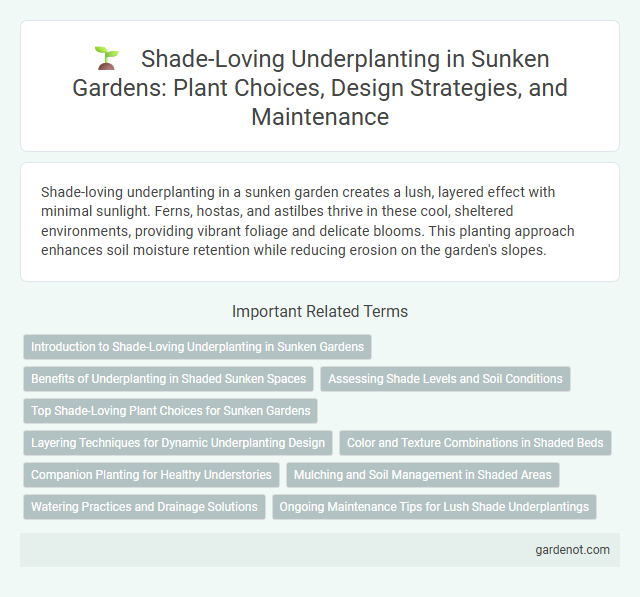Shade-loving underplanting in a sunken garden creates a lush, layered effect with minimal sunlight. Ferns, hostas, and astilbes thrive in these cool, sheltered environments, providing vibrant foliage and delicate blooms. This planting approach enhances soil moisture retention while reducing erosion on the garden's slopes.
Introduction to Shade-Loving Underplanting in Sunken Gardens
Shade-loving underplanting in sunken gardens enhances aesthetic appeal while maximizing growth in low-light areas. Plants such as hostas, ferns, and astilbes thrive beneath taller shrubs or trees, creating lush, layered textures with minimal sunlight. Incorporating these perennials supports soil health and biodiversity, promoting a vibrant, sustainable garden ecosystem.
Benefits of Underplanting in Shaded Sunken Spaces
Shade-loving underplanting in sunken gardens enhances soil moisture retention and reduces erosion due to dense ground cover. These plants improve biodiversity by providing habitat for beneficial insects and small wildlife, promoting a balanced ecosystem. Underplanting also enriches the soil through organic matter decomposition, leading to healthier plant growth in shaded, lower-lying garden areas.
Assessing Shade Levels and Soil Conditions
Evaluating shade levels in a sunken garden is crucial for selecting shade-loving underplanting that thrives under limited sunlight, typically between 10-40% shade. Soil conditions, including moisture retention and pH balance, directly influence plant health and growth, with loamy, well-drained soil preferred for most shade-tolerant species. Accurate assessment of these factors ensures optimal underplanting choices, enhancing biodiversity and visual appeal in shaded garden areas.
Top Shade-Loving Plant Choices for Sunken Gardens
Hostas, ferns, and astilbes thrive as top shade-loving plants in sunken gardens due to their ability to flourish in low-light conditions and provide rich texture and color contrast. These plants also contribute to soil moisture retention and offer diverse foliage shapes and seasonal blooms, enhancing the garden's layered appearance. Incorporating shade-tolerant groundcovers like ajuga and lamium helps suppress weeds and maintain a lush, verdant underplanting beneath taller shrubs and trees.
Layering Techniques for Dynamic Underplanting Design
Shade-loving underplanting in sunken gardens thrives by employing layering techniques that combine diverse foliage textures and heights to create depth and visual interest. Utilizing plants such as Hostas, Ferns, and Heucheras in descending order enhances the dynamic structure while maximizing shade tolerance. Incorporating groundcovers like Ajuga and Lamium at the lowest layer ensures year-round color and soil protection, completing a vibrant and sustainable design.
Color and Texture Combinations in Shaded Beds
Shade-loving underplanting in sunken gardens thrives with a mix of hostas, ferns, and astilbes, offering a vibrant palette of greens, purples, and pinks. Combining the broad, textured leaves of hostas with the feathery fronds of ferns and the delicate blooms of astilbes creates dynamic layers that enhance the garden's depth. Selecting plants based on contrasting leaf shapes and complementary colors maximizes visual interest and vitality in shaded beds.
Companion Planting for Healthy Understories
Shade-loving underplanting in sunken gardens thrives with companion planting, where species such as hostas, ferns, and astilbes create a healthy understory by improving soil moisture retention and providing natural pest resistance. These companions enhance biodiversity and support beneficial insects, promoting a balanced ecosystem beneath taller shade trees. Strategic selection of shade-tolerant plants ensures vigorous growth and dense ground cover, effectively reducing weed competition and soil erosion.
Mulching and Soil Management in Shaded Areas
Mulching in shaded areas of sunken gardens conserves moisture, suppresses weeds, and enriches soil organic matter, which benefits shade-loving underplanting such as hostas and ferns. Applying a 2-3 inch layer of organic mulch like shredded bark or leaf mold enhances soil structure and promotes microbial activity essential for nutrient cycling. Regular soil testing and amended topsoil with compost help maintain optimal pH and nutrient levels, ensuring healthy root development and vigorous growth in the low-light conditions.
Watering Practices and Drainage Solutions
Shade-loving underplanting in sunken gardens requires consistent moisture without waterlogging, necessitating efficient watering practices such as drip irrigation or soaker hoses to maintain soil hydration. Proper drainage solutions, including the installation of French drains or raised beds with well-aerated soil, prevent root rot and promote healthy growth. Incorporating organic mulch enhances moisture retention while facilitating gradual water infiltration and improved soil structure.
Ongoing Maintenance Tips for Lush Shade Underplantings
Shade-loving underplantings in sunken gardens require regular moisture monitoring and mulching to maintain healthy soil conditions and prevent root rot. Periodic pruning and removal of dead foliage encourage vigorous growth and enhance air circulation, minimizing fungal issues. Implementing seasonal fertilization with slow-release, balanced nutrients supports sustained lushness and vibrant leaf color.
Shade-loving underplanting Infographic

 gardenot.com
gardenot.com